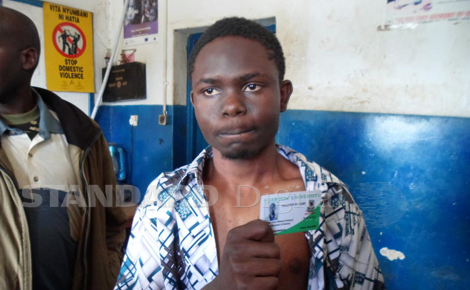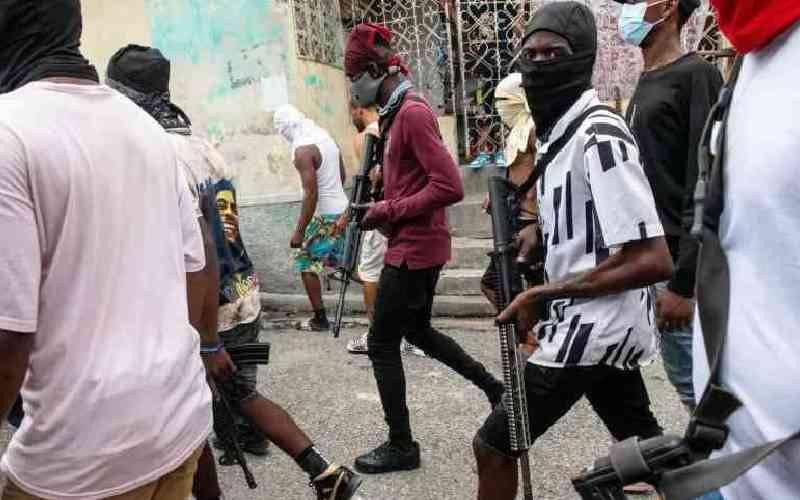 |
Victor Mwania, 19, displays his university identity card after he was arrested
with his colleague Richard Gitamar. The two ?rst-year Egerton University
students were accused of kidnapping a nine-year-old girl at Moi’s Bridge in
Uasin Gishu County and demanded a Sh5 million ransom from her father.
Security researchers have mapped out major crime hotspots in the country.
[PHOTOS: KEVIN TUNOI/STANDARD] |
NAIROBI, KENYA: Security researchers have mapped out areas where you are likely to be attacked by criminals and possibly get killed.
In Kajiado County, Noonkopir and Changombe slums in Kitengela, Majengo, Kisaju Road in Isinya, Kware, Gataka Road and Wama Road in Ongata Rongai, areas around Kiserian Primary School, the Ngong Road stretch and Kiwanja ya Punda are listed as hotspots.
And in Kiambu, Kiandutu, the flyover heading into Thika town, Ngeta Field and Muchatha in Thika, the railway line junction, Nairobi-Nakuru highway, the stretch to Kikuyu town, Patel Bridge in Kikuyu town, Mashimoni-Marimani roads and the Kiambu-Nairobi highway, the stretch between the Nakuru highway and Limuru town and bus stop are listed as dangerous areas.
In Machakos, Kanaani, Railways and Kisumu Ndogo in Athi River, Matharau Street, Slanga Dam and Ngwata in Mlolongo, the Nairobi-Kangundo highway and Sewage in Ruai, Sovia, Devik, Bondeni and Makadara in Mavoko are hotspots.
The report found that crime is usually committed between 6pm and 9pm, and incidents targeting businesses and residential houses in Nairobi were relatively low compared to Kiambu and Kajiado.
Inspector General of Police David Kimaiyo presided over the report launch and announced several measures taken to address the situation. The study, titled ‘Nairobi Metropolitan Area’, covered 2012 and 2013 and sampled 17 areas in the counties where residents have faced an increase in general crime.
“Both business and residents have, due to unrelenting crime attacks, made provisions for home and business security an integral part of their design, as opposed to the situation in the outlying counties, which were only beginning to feel the heat of the crime wave and were yet to make plans to control and manage it,” said part of the report.
The report said crime rose in the period under study by five per cent from 41 per cent recorded in 2011/2012 to 46.9 per cent, while the number of people reporting crime had dropped to 38 per cent in 2012/2013 from the 51 per cent recorded in 2011/2012.
“The drop in reporting crime invariably translates to loss of confidence by the public in the police largely attributed to police inaction, corruption, travel costs to police stations, fear of reprisal from perpetrators and a preference for alternative dispute resolution mechanisms.”
The report showed youths were blamed for the rate of crime, with 78 per cent of those sampled saying they were attacked by the group; 16 per cent blamed middle-aged people and 2.7 per cent women.
FERRYING GUNS
Women were found to provide peripheral support to their male accomplices by being used to undertake crimes like ferrying guns and drugs as well as offering logistical support.
Theft remains the main crime committed in big slums in the country. The report sampled Kibera in Nairobi, Mishomoroni in Mombasa, Manyatta in Kisumu and Bondeni in Nakuru, where it was established 35 per cent of the respondents said theft was rampant while 15 per cent cited robbery, 10 per cent break-ins, and 23 per cent muggings.
The study further established that 98 per cent of the respondents had witnessed a crime being committed in the first three months of the year under study.
More than 61 per cent of the respondents cited youth unemployment as the main cause of crime while 11 per cent cited poverty and nine per cent drug abuse.
Stay informed. Subscribe to our newsletter
Bondeni slums in Nakuru was found to be the most unsafe place to live at 60 per cent followed by Mishomoroni in Mombasa at 44 per cent, followed by Kibera at 40 per cent and Manyatta at 36 per cent.
Some 81 per cent of respondents in the slums felt crime remained high.
There were 21 organised criminal gangs found to be operating in the slums, with Kibera having six, Mishomoroni eight, Bondeni eight and Manyatta four.
Extortion, levying of protection fees, muggings, heckling and disrupting political rallies, drug trafficking and kidnappings were the main crimes committed in slums. There were 17 hotspots identified in Kibera, 11 in Mishomoroni, nine in Bondeni and seven in Manyatta.
The gangs of Kibera include 42 Brothers, Man Man, Kimungu Group, Mungiki, Kogo Boys and Five Brothers. Mishomoroni has Kaya Bombo, Majambazi, Washefa, Magaidi, Mateja, Jihadi and Maunga Washahihi while Bondeni has Majaveli, Backyard, Mtaro Base, Wajanja, Wazalendo, Genge Juu, Lumumba and Westside.
Those operating in Manyatta are Baghdad, China Squad, American Marines and Somali Squad.
The hotspots of Kibera are Darajani, Laini Saba playground, the bridge next to Corner Club in Bombolulu, the forest between Kibera and Ngong Road, behind Raila Education Centre, behind Bombolulu Bar, Stage 42, the railway and the boundary of Gatwekera and Soweto, around Subra Plaza, Fort Jesus, Equity Bank and near Kicoshep and Ayani primary schools, and Jasega.
 The Standard Group Plc is a
multi-media organization with investments in media platforms spanning newspaper
print operations, television, radio broadcasting, digital and online services. The
Standard Group is recognized as a leading multi-media house in Kenya with a key
influence in matters of national and international interest.
The Standard Group Plc is a
multi-media organization with investments in media platforms spanning newspaper
print operations, television, radio broadcasting, digital and online services. The
Standard Group is recognized as a leading multi-media house in Kenya with a key
influence in matters of national and international interest.
 The Standard Group Plc is a
multi-media organization with investments in media platforms spanning newspaper
print operations, television, radio broadcasting, digital and online services. The
Standard Group is recognized as a leading multi-media house in Kenya with a key
influence in matters of national and international interest.
The Standard Group Plc is a
multi-media organization with investments in media platforms spanning newspaper
print operations, television, radio broadcasting, digital and online services. The
Standard Group is recognized as a leading multi-media house in Kenya with a key
influence in matters of national and international interest.









